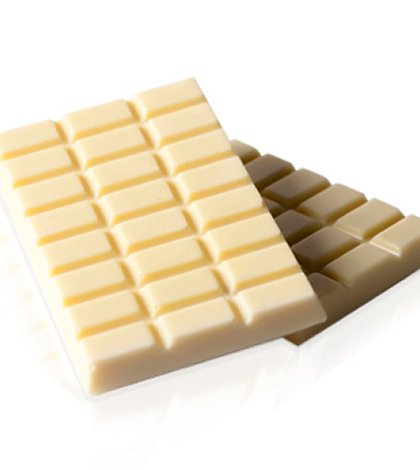The first white chocolate bar was manufactured and introduced in Europe, by the Swiss company: Nestle, in 1930. This version of chocolate is a derivative, or an off-shoot from regular chocolate. One obvious difference is its ivory or pale yellow appearance. It commonly consists of salt, sugar, cocoa butter, and milk. Also, the cocoa butter, which happens to be the chief ingredient in the cocoa bean itself, happens to have a high melting point, which allows it to remain rather solid at room temperatures. This type of chocolate is not considered actual chocolate, because it does not contain cocoa solids. This is the primary, nutritious item of chocolate liquor.
During the process of making this type of chocolate, the dark-colored solids from the cocoa beans are separated from the fatty contents (such as with dark and semi-sweet dark chocolate and milk), and these solids are not recombined, hence the name: White Chocolate. Another key difference between dark and white is that it does not include any antioxidants found normally in dark chocolates; these include: theobromine, thiamine, riboflavin, and phenyl ethylamine, and the cocoa butter itself is deodorized, so as to remove its strong taste. There is a preparation process, identified as confectioner’s coating, or a simmer coating, which can be confused with this type of chocolate. These coatings are manufactured from inexpensive ingredients, which are hydrogenated/solid vegetable and animal fats. These items do not come from the familiar cocoa, and preparing it this way gives its white color, or an ivory shade. Preparing it in this manner will also have it lack the cocoa butters flavor.
Current regulations preside over what can be marketed as “white chocolate”: Since 2004 in the USA, this product must be (by its weight) at least 3.5% milk fat, 20% cocoa butter, 14% total milk solids, and no more than 55% sugar, and or other sweeteners. The European Union has taken the same standards into account; but their only exceptions are: they have no limit on sweeteners or sugar. Also, this type of chocolate does not contain any cocoa solids, and has only trace amounts of the known stimulants: caffeine and theobromine.
Research has shown that this chocolate type has positive health benefits; for one, it can enhance cardiovascular health. It improves circulation, and one ingredient: Flavonoids, keeps our arteries from clumping together, as a result, this reduces our risk of getting heart disease. When consumed in moderation, white chocolate can also lower ones blood pressure. As children, we were told that candy was not good for us, but as medical research has shown, consuming some chocolates, have their benefits.
Frank Malloy

 Fitness & Sports52 years ago
Fitness & Sports52 years ago
 Recipes52 years ago
Recipes52 years ago
 Articles52 years ago
Articles52 years ago
 Entertainment52 years ago
Entertainment52 years ago
 Beauty52 years ago
Beauty52 years ago
 Entertainment52 years ago
Entertainment52 years ago
 Entertainment52 years ago
Entertainment52 years ago
 Entertainment52 years ago
Entertainment52 years ago













